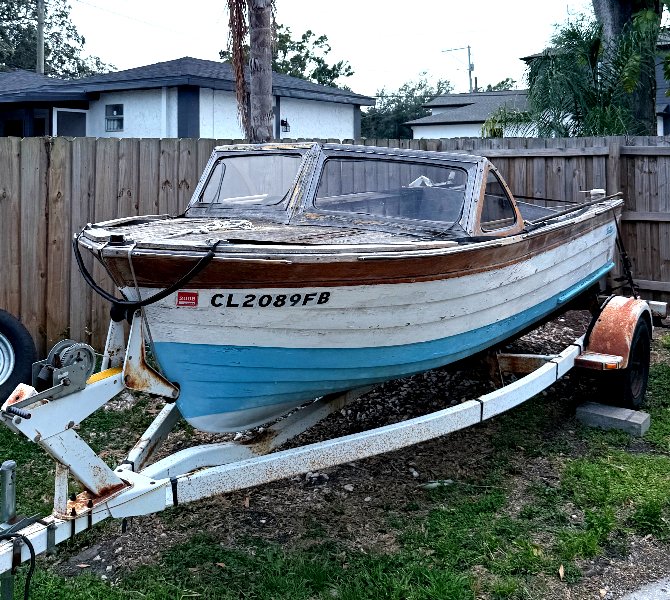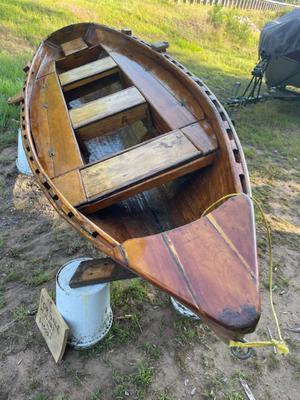- Home
- Your Boats
- This Page
Making water tight and testing
by Simon
(Solent, UK)

Hull before any work
I have an 11' wooden Gull sailing Dinghy, which I've owned for nearly 6 years.
It's probably about 40 years old, plywood, and has had some level of unknown repair and restoration in the past.
When not in use she is kept in my garage, but she has not been sailed for the last two years.
Effectively we decided she is taking on too much water (over my feet in 10 minutes, whilst tied up to a pontoon).
The boat was retrospectively fitted with a self-bailer, but it’s totally useless, you can never get the boat going fast enough for it to work.
Constantly having to bail out removes the enjoyment.
We only use it for some family fun on our local river, and my 5 year old daughter is eager for us to take it out again.
In my mind the boat is not worth much, a few hundred pounds, so might as well have a go at fixing her up.
So how to go about it?
It would be nice to know where she is leaking: seems, cracks, past the copper nails and screws, or other.
Last summer I sat her in the water to try and see where the leaks are coming from.
Before the test I removed a significant amount of paint from the inside of the floor.
The leaks appeared to be through the floor pan, close to the centre board casing, though not specifically through the centre board casing.
Hard to be sure exactly where the water is coming through as it might run under paint or under some structural timber before popping up at what is probably the lowest point.
There are quite a few cracks in the paint work on the hull, but can’t be sure if this goes through to the wood without removing the paint.
Next I’ve started stripping the paint off the bottom of the hull to explore those cracks.
After 5 sessions with the Marine Strip and final blast with the Orbital Sander, sure enough I’ve found some cracks in the plywood.
My first question is should I just dress the individual cracks (presumably with epoxy)?
I can see someone has done something similar on other parts.
Alternatively, would it be better to glass fibre or epoxy a large section of hull?
My second question is, what’s the best way to test if the leaks have been resolved?
If I’ve dressed the individual cracks or even epoxied over a section of the hull, I want to know I’ve done the job, before I start repainting.
I guess the obvious answer is to float her on the water, but is this a good idea before repainting?
Surely the paint acts as one of the barriers that makes the boat water tight.
What about filling the inside of the boat with water to see where it drains out?
I’ve attached 4 photos, the first just shows the upturned hull before I’ve done anything to it.
The 2nd and 3rd photos show typical cracks I’ve found, of which I’ve found about 4 or 5 so far.
In the 4th photo you will see I’ve only been working on the starboard side of the hull and a section covering about two thirds the length.
Hopefully you’ll also see where I’ve placed the 4 pound coins indicating where I’ve found cracks so far.
Comments for Making water tight and testing
|
||
|
||
|
||
Want to add more photos?
Photo Uploader
If you are having problems uploading Photos or would like to add more click on this link for the Upload Form.














